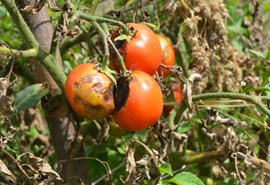
Tomato blight is a common disease that can be a serious problem for gardeners and can destroy your entire crop if you do not act quickly. It can be alarming to the novice gardener, but understanding blight can help to minimise the risk of it taking hold on your plot. To help, we’ve prepared a guide on how to recognise and tackle tomato blight. Read more below.
What is tomato blight?
Tomato blight is a fungal infection called Phytophthora infestans which spreads by wind and water splash. It is triggered by warm, wet conditions and fungal spores can be carried over 30 miles on the wind, making tomato crops grown outside more susceptible than those growing in a
polytunnel or greenhouse. When blight hits, the crop is quickly ruined and even picking the fruits at the first sign of infection cannot stop them from rotting.
What does tomato blight look like?
The first sign of blight in tomatoes is usually leaves turning brown and shrivelling. Brown lesions also appear on the leaf stalks and plant stems. The fruits on the plant will develop brown sunken spots, with mature fruit rotting more quickly on the vine when infected.
How to prevent tomato blight
Blight can quickly destroy your tomato crop and although polytunnel grown tomatoes are more protected, this disease can still be a serious problem to overcome. While you cannot entirely escape the risk of blight during a wet British summer, you can reduce the chances of losing your whole crop by following this advice:
Keep tomato plant leaves dry
When watering your tomato plants, take care to only water the soil or compost, keeping the leaves dry. Blight is more likely to take hold when the leaves are wet.
Support or tie up tomato plants to keep the leaves off the wet soil.
Grow tomatoes in a polytunnel if possible, as this will keep the leaves dry and also help fruits ripen sooner than tomatoes grown outside.
If you do grow your tomatoes outside and blight hits, try placing a
polythene cloche over your crop to keep them out of the wind and rain.
Water in the morning
You should water your tomato plants in the morning, if possible, to allow things to dry out before the temperature drops at night, and to avoid the plants sitting in damp soil overnight.
Provide good ventilation
Keep your polytunnel well-ventilated on hot days by opening doors or vents – not only does this increase air flow through the polytunnel, it also prevents it becoming too humid inside.
You should try to leave enough space between the plants to allow air to circulate – avoid sowing and planting your tomatoes closer than the seed packet recommends.
Remove lower leaves
Increase air circulation around your tomato plants by removing the lower leaves up to the first fruit trusses. Not only will the increased ventilation help to reduce the risk of blight taking hold, removing the lower leaves will also allow more light in to the ripening fruits.
 Feed tomato plants with a high potassium feed
Feed tomato plants with a high potassium feed
Tomato plants need feeding to encourage good fruits. You should feed tomatoes with a high potassium feed, never a high nitrogen one. This is because high nitrogen fertilisers boost leaf growth at the expense of the fruit, making your crop most susceptible to blight.
Crop rotation
It’s important to practice good crop rotation when growing tomatoes. Since blight spores can remain in the soil, you should avoid growing tomatoes in the same area or the same soil year after year. Ideally, you should wait four years before planting tomatoes in the same location.
Avoid planting tomatoes near potatoes
Potato crops are also susceptible to blight, so making sure your tomato plants are not planted near to these will help to avoid blight spreading between the crops.
Clean and clear
Keeping on top of cleanliness in your growing space will help to minimise blight taking hold. However, if you do notice that your tomatoes have some blight, you should remove and dispose of the infected plants quickly to reduce the chance of further infection on your plot. Infected plants can be disposed of in council compost bins where material is composted at a much higher temperature, therefore slowing down the rate of infection.
Clean plant supports and tools that have been used on infected plants, and wash your hands thoroughly to prevent spreading the fungal spores to other crops.
When the weather conditions are favourable for blight, keep checking plants regularly for any signs of infection.
Blight resistant tomatoes
If you have tackled a blight problem before, you may want to consider growing blight resistant tomatoes for a while. Some tomato varieties that have been bred to be blight tolerant are:
- Crimson Blush Beefsteak F1
- Crimson Cherry F1
- Crimson Crush F1
- Fandango
- Fantasio F1
- Latah
- Lizzano F1
- Losetto F1
- Mountain Magic F1
- Red Alert
The thought of losing an entire crop can be alarming, so it’s important to remember that blight doesn’t have to mean the end of your growing season – you can still have a successful harvest of other crops and you can always try
growing tomatoes again next year.